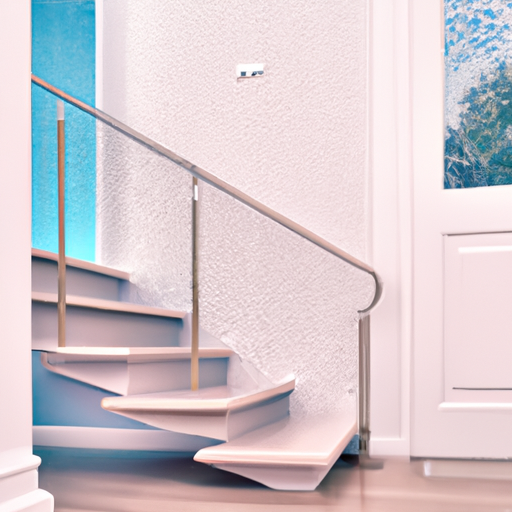Achieving Aesthetic Harmony: The Role of Architectural Consistency in Home Design
The importance of architectural consistency in home design cannot be overstated. A well-designed home is not only a reflection of the homeowner’s taste and personality, but it also contributes to the overall aesthetic appeal and value of the property. Achieving aesthetic harmony in a home requires a keen eye for detail and a deep understanding of the principles of architectural consistency. This article will explore the role of architectural consistency in home design and provide insights on how to achieve a harmonious and visually appealing living space.
Architectural consistency refers to the harmonious integration of various design elements, such as materials, colors, textures, and patterns, to create a cohesive and visually appealing space. This concept is rooted in the belief that a well-designed home should have a unified and consistent theme that runs throughout the entire property. This theme can be based on a specific architectural style, such as modern, traditional, or eclectic, or it can be a more abstract concept, such as minimalism or sustainability.
One of the primary reasons why architectural consistency is essential in home design is that it helps create a sense of balance and harmony. A home with a consistent design theme is more likely to feel inviting and comfortable, as the various elements work together to create a unified and cohesive atmosphere. This sense of harmony can also contribute to the overall aesthetic appeal of the property, making it more attractive to potential buyers and increasing its value.
In addition to creating a harmonious living space, architectural consistency also plays a crucial role in ensuring the functionality of a home. A consistent design theme can help guide the layout and organization of the various rooms and spaces within the property, ensuring that they flow seamlessly from one area to the next. This can make the home more efficient and easier to navigate, as well as more enjoyable to live in.
Achieving architectural consistency in home design requires careful planning and attention to detail. One of the first steps in this process is to determine the overall design theme or style that will be used throughout the property. This can be based on personal preferences, the architectural style of the surrounding neighborhood, or even the specific requirements of the property itself, such as its size, shape, or location.
Once the overall design theme has been established, it is essential to ensure that all of the various design elements, such as materials, colors, textures, and patterns, are consistent with this theme. This can be achieved by selecting materials and finishes that complement each other and by using a consistent color palette throughout the property. It is also important to consider the scale and proportion of the various design elements, as this can help create a sense of balance and harmony within the space.
In addition to focusing on the visual aspects of architectural consistency, it is also essential to consider the functional aspects of the design. This includes ensuring that the layout and organization of the various rooms and spaces within the property are consistent with the overall design theme and that they flow seamlessly from one area to the next. This can be achieved by carefully planning the layout of the property and by considering factors such as natural light, ventilation, and circulation.
In conclusion, architectural consistency plays a vital role in achieving aesthetic harmony in home design. By carefully considering the various design elements and ensuring that they are consistent with the overall design theme, homeowners can create a harmonious and visually appealing living space that is both functional and enjoyable to live in. This, in turn, can contribute to the overall value and appeal of the property, making it a worthwhile investment for years to come.
Balancing Form and Function: How Architectural Consistency Enhances Living Spaces

The importance of architectural consistency in home design cannot be overstated. A well-designed home is not only aesthetically pleasing but also functional, comfortable, and efficient. Achieving this balance between form and function is a delicate process that requires careful consideration of various factors, including the architectural style, materials, and layout. By maintaining architectural consistency throughout the design process, homeowners can create living spaces that are both visually appealing and highly functional.
Architectural consistency refers to the harmonious integration of various design elements, such as the choice of materials, colors, and textures, as well as the overall layout and flow of the space. This concept is particularly important in home design, as it helps to create a cohesive and unified look that enhances the overall aesthetic appeal of the property. Moreover, a consistent design approach can also contribute to the functionality and efficiency of the home, as it ensures that all spaces are well-organized and easy to navigate.
One of the key aspects of architectural consistency is the selection of materials. By using a consistent palette of materials throughout the home, designers can create a sense of unity and harmony that ties the entire space together. This not only enhances the visual appeal of the property but also contributes to its overall functionality. For example, using the same flooring material throughout the home can help to create a seamless flow between rooms, making it easier for occupants to move from one space to another. Similarly, using the same type of windows and doors can help to create a consistent look and feel, while also ensuring that the home is well-insulated and energy-efficient.
Another important aspect of architectural consistency is the overall layout and flow of the space. A well-designed home should have a logical and intuitive layout that makes it easy for occupants to navigate and use the various spaces. This can be achieved by carefully considering the placement of rooms, as well as the arrangement of furniture and other design elements. For example, placing the kitchen and dining area close to each other can help to create a more efficient and functional space, as it allows for easy access and movement between the two areas. Similarly, positioning the bedrooms away from noisy living areas can help to create a more peaceful and restful environment.
Color and texture also play a crucial role in maintaining architectural consistency. By using a consistent color scheme and texture throughout the home, designers can create a cohesive and harmonious look that enhances the overall aesthetic appeal of the property. This can be achieved by selecting colors and textures that complement each other and work well together, as well as by using similar design elements, such as lighting fixtures and furniture, throughout the space.
In conclusion, architectural consistency is an essential aspect of home design that should not be overlooked. By carefully considering the choice of materials, colors, textures, and layout, homeowners can create living spaces that are both visually appealing and highly functional. Moreover, a consistent design approach can also contribute to the overall efficiency and comfort of the home, as it ensures that all spaces are well-organized and easy to navigate. Ultimately, achieving a balance between form and function is the key to creating a successful and enjoyable living environment.
Timeless Appeal: The Lasting Impact of Architectural Consistency on Home Value
The importance of architectural consistency in home design cannot be overstated. A well-designed home not only provides a comfortable and functional living space for its occupants, but also contributes to the overall aesthetic appeal and value of the property. Architectural consistency refers to the harmonious blending of various design elements, such as materials, colors, and styles, to create a cohesive and visually pleasing environment. This timeless appeal has a lasting impact on the home’s value, making it a crucial consideration for homeowners and potential buyers alike.
One of the primary reasons architectural consistency is so important in home design is that it creates a sense of unity and balance throughout the space. When all the elements of a home’s design work together seamlessly, it creates a visually appealing environment that is both inviting and comfortable. This is particularly important in open-concept living spaces, where the various rooms and areas of the home flow into one another. A consistent design theme helps to create a sense of continuity and cohesion, making the space feel more expansive and well-planned.
In addition to its aesthetic benefits, architectural consistency also contributes to the overall functionality of a home. When the various elements of a home’s design are in harmony with one another, it creates a more efficient and user-friendly environment. For example, a consistent color palette can help to create a sense of flow and movement throughout the space, making it easier for occupants to navigate from one area to another. Similarly, the use of complementary materials and finishes can help to create a more cohesive and durable living environment, ensuring that the home remains in good condition for years to come.
Architectural consistency is also an important factor in determining the value of a home. A well-designed and cohesive home is more likely to attract potential buyers and command a higher price on the market. This is because a consistent design theme not only makes the home more visually appealing, but also suggests that the property has been well-maintained and cared for. Buyers are often willing to pay a premium for a home that has been thoughtfully designed and maintained, as it suggests that the property will require less work and investment in the long run.
Furthermore, a home with a timeless and consistent design is more likely to retain its value over time. As design trends come and go, a home that adheres to a classic and enduring aesthetic is less likely to become dated or fall out of favor. This is particularly important in today’s fast-paced and ever-changing design landscape, where trends can quickly become obsolete. By investing in a timeless and architecturally consistent design, homeowners can ensure that their property remains attractive and valuable for years to come.
In conclusion, the importance of architectural consistency in home design cannot be overstated. A well-designed and cohesive home not only provides a comfortable and functional living environment for its occupants, but also contributes to the overall aesthetic appeal and value of the property. By adhering to a consistent design theme and incorporating timeless design elements, homeowners can create a living space that is both visually pleasing and enduringly valuable. As the saying goes, “a thing of beauty is a joy forever,” and this is certainly true when it comes to the lasting impact of architectural consistency on home value.
Q&A
Question 1: Why is architectural consistency important in home design?
Answer 1: Architectural consistency is important in home design because it ensures a harmonious and aesthetically pleasing environment, enhances the overall functionality of the space, and maintains the architectural integrity of the home, which can positively impact its resale value.
Question 2: How does architectural consistency affect the functionality of a home?
Answer 2: Architectural consistency affects the functionality of a home by creating a seamless flow between spaces, improving wayfinding and navigation, and ensuring that all elements of the design work together to support the intended use of each room, ultimately enhancing the overall living experience.
Question 3: What are some ways to achieve architectural consistency in home design?
Answer 3: To achieve architectural consistency in home design, consider using a cohesive color palette, consistent materials and finishes, maintaining a uniform style throughout the home, and ensuring that architectural elements such as windows, doors, and trim work are in harmony with the overall design.
Conclusion
In conclusion, architectural consistency in home design is crucial as it ensures a harmonious and aesthetically pleasing environment, enhances the functionality and flow of spaces, preserves the historical and cultural context, and contributes to the overall value of the property. By maintaining a consistent design approach, architects and homeowners can create spaces that are not only visually appealing but also practical and comfortable for inhabitants.


